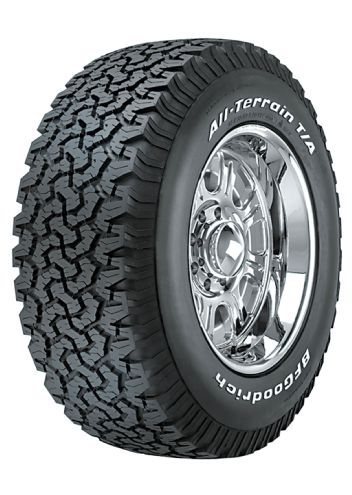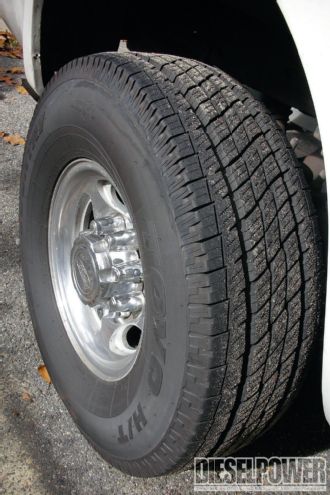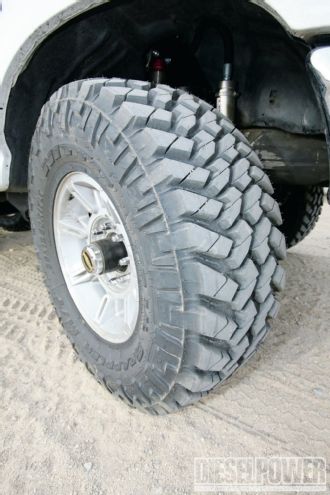The tire market is a huge industry and, in many ways, it’s as diverse as the uses we have for our diesels. Mud-terrains allow the off-roader to navigate rugged terrain and provide a tough look. All-terrains, while less aggressive in tread design, offer a combination of off-road and on-road performance. Less aggressive yet, all-season tires typically encompass high load capacities, low road noise, and great wear characteristics. Which tire you choose depends greatly on your truck’s intended use. This month, we’ll discuss the tire basics, including load and speed ratings, what the writing on the sidewall means, metric vs. standard sizes, and how to best maintain them.
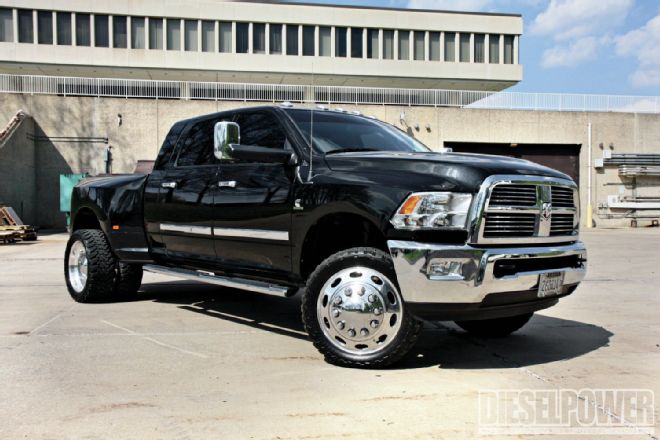
| 2010 Dodge Ram 3500 Front Three Quarter
The owner of this ’10 Ram 3500 had 22.5-inch American Force wheels cut down to 22 inches, then mounted six 33x12.50R22LT Toyo Open Country M/Ts on them. The result is a truck that sports a unique wheel and tire package. Now let’s dissect its tire specs…
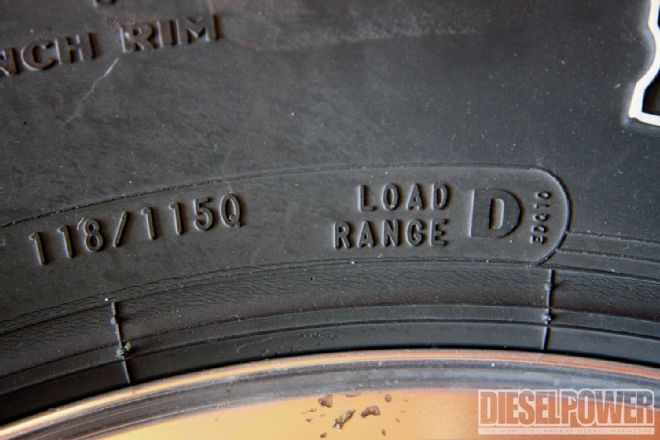
| In contrast to the Toyo Open Country M/Ts previously mentioned, the sidewall on this 305/70R16 Mickey Thompson Baja MTZ says they’re rated for a higher load carrying capacity (118 equates to 2,910 pounds per tire) yet are D-rated tires. This is why you should look beyond a simple load rating when hunting for a set of tires for your truck. Note: the 115 number of the 118/115Q is the load index number in dual rear wheel configurations. Like the Toyos, however, these Baja MTZs have a Q speed rating (99 mph). A full speed-rating chart is available at tirerack.com.
Load Rating vs. Load Capacity
For trucks that spend their life saddled with a trailer or a bed full of rock, load ratings and capacities are at the forefront of their owners’ tire buying needs. This is where distinguishing between load rating and load capacity is of utmost importance. For instance, a lot of folks who tow or haul seek out an E-rated tire. This is a good start, but load capacity (per tire) or load index are the numbers they should really be looking for. This is because load ratings can be misleading: where brand X offers an E-rated tire that has the same (or lower) load capacity as brand Y’s D-rated tire.
Load index is another way of displaying a tire’s load-carrying capacity. The load index value for most truck tires will fall between 109 and 130 (2,271 pounds to 4,190 pounds, respectively). However, keep in mind that a tire with a load index at the low end of that spectrum and one with say, a 126 value, can both be E-rated. A great load index chart is available at discounttire.com.
Metric vs. Standard
With most tire sizes listed in their metric version these days (305/50R20, for example), a tire’s overall inflated height isn’t made clear. Because this is often the first dimension we want to know when tire shopping, it’s important to be able to convert metric sizes into standard ones (such as 33x12.50R20). Using a 305/50R20 tire as an example, we take 305 (the tire’s width in millimeters) and divide it by 10 in order to convert from millimeters to centimeters. Because 1 centimeter equals 0.393 inch, our 30.5 number gets multiplied by 0.393, which gives us the tire’s width of 11.99 inches. With the sidewall being 50 percent of the tire’s width in our case (305/50R20), we multiply 11.99 by 0.50 and arrive at 5.995 inches. Because a tire has both a top and a bottom sidewall, our 5.995 must be multiplied by 2, giving us 11.99 inches. From there, we add in the rim’s overall height of 20 inches, which leads us to a 32-inch overall tire height.
Tire Makeup
Tougher construction sets light-truck tires apart from passenger car tires. As a whole, they’re much stiffer and heavier and can run at a much higher pressure (typically 80 psi), which increases load capacity while lessening rolling resistance. Light-truck tires feature multiple plies (composed of polyester, steel, nylon, or armid) that run perpendicular to the tread itself. Depending on which type of tire you’re using, its compound may seem harder (all-season highway tires) or softer (all-terrain or mud tires) than others.
Maintenance
It’s big bucks to fit your truck with the tread of your choice -- so maintenance is key to making tires last. First and foremost, pay attention and adhere to the manufacturer’s recommended rotation interval for even wear and maximum longevity. Check your air pressure periodically, as over or under-inflation can lead to premature wear. Also ensure your tires are correctly aligned to avoid quick wear. Be mindful that letting your tires sit in extreme weather -- especially sunlight -- for extended periods of time will lead to dry-rotting (cracking and splitting of the rubber). If you have no other choice but to let a vehicle sit, invest in a tire protectant coating for your tread of choice. Tire protectants can keep dry-rotting at bay using UV stabilizers that actually absorb into the rubber. Last but not least, have realistic expectations. Tires don’t last forever, and whether through use or by age, they will eventually need to be replaced.
TIRE BREAKDOWN
Spec: What it means:
33x12.50R22LT 33-inch overall diameter, 12.5-inch overall width, 22-inch overall wheel diameter, light-truck tire
Tread construction of 3P+2S+2N 3 ply polyester, 2 steel belts, 2 nylon cap plies
Sidewall construction of 3P 3 ply polyester
Q speed rating Rated for 99 mph
E load rating, 109 load index value Load-carrying capacity of 2,271 pounds per tire
 | 2010 Dodge Ram 3500 Front Three Quarter
The owner of this ’10 Ram 3500 had 22.5-inch American Force wheels cut down to 22 inches, then mounted six 33x12.50R22LT Toyo Open Country M/Ts on them. The result is a truck that sports a unique wheel and tire package. Now let’s dissect its tire specs…
| 2010 Dodge Ram 3500 Front Three Quarter
The owner of this ’10 Ram 3500 had 22.5-inch American Force wheels cut down to 22 inches, then mounted six 33x12.50R22LT Toyo Open Country M/Ts on them. The result is a truck that sports a unique wheel and tire package. Now let’s dissect its tire specs…  | In contrast to the Toyo Open Country M/Ts previously mentioned, the sidewall on this 305/70R16 Mickey Thompson Baja MTZ says they’re rated for a higher load carrying capacity (118 equates to 2,910 pounds per tire) yet are D-rated tires. This is why you should look beyond a simple load rating when hunting for a set of tires for your truck. Note: the 115 number of the 118/115Q is the load index number in dual rear wheel configurations. Like the Toyos, however, these Baja MTZs have a Q speed rating (99 mph). A full speed-rating chart is available at tirerack.com.
Load Rating vs. Load Capacity
For trucks that spend their life saddled with a trailer or a bed full of rock, load ratings and capacities are at the forefront of their owners’ tire buying needs. This is where distinguishing between load rating and load capacity is of utmost importance. For instance, a lot of folks who tow or haul seek out an E-rated tire. This is a good start, but load capacity (per tire) or load index are the numbers they should really be looking for. This is because load ratings can be misleading: where brand X offers an E-rated tire that has the same (or lower) load capacity as brand Y’s D-rated tire.
Load index is another way of displaying a tire’s load-carrying capacity. The load index value for most truck tires will fall between 109 and 130 (2,271 pounds to 4,190 pounds, respectively). However, keep in mind that a tire with a load index at the low end of that spectrum and one with say, a 126 value, can both be E-rated. A great load index chart is available at discounttire.com.
| In contrast to the Toyo Open Country M/Ts previously mentioned, the sidewall on this 305/70R16 Mickey Thompson Baja MTZ says they’re rated for a higher load carrying capacity (118 equates to 2,910 pounds per tire) yet are D-rated tires. This is why you should look beyond a simple load rating when hunting for a set of tires for your truck. Note: the 115 number of the 118/115Q is the load index number in dual rear wheel configurations. Like the Toyos, however, these Baja MTZs have a Q speed rating (99 mph). A full speed-rating chart is available at tirerack.com.
Load Rating vs. Load Capacity
For trucks that spend their life saddled with a trailer or a bed full of rock, load ratings and capacities are at the forefront of their owners’ tire buying needs. This is where distinguishing between load rating and load capacity is of utmost importance. For instance, a lot of folks who tow or haul seek out an E-rated tire. This is a good start, but load capacity (per tire) or load index are the numbers they should really be looking for. This is because load ratings can be misleading: where brand X offers an E-rated tire that has the same (or lower) load capacity as brand Y’s D-rated tire.
Load index is another way of displaying a tire’s load-carrying capacity. The load index value for most truck tires will fall between 109 and 130 (2,271 pounds to 4,190 pounds, respectively). However, keep in mind that a tire with a load index at the low end of that spectrum and one with say, a 126 value, can both be E-rated. A great load index chart is available at discounttire.com.
